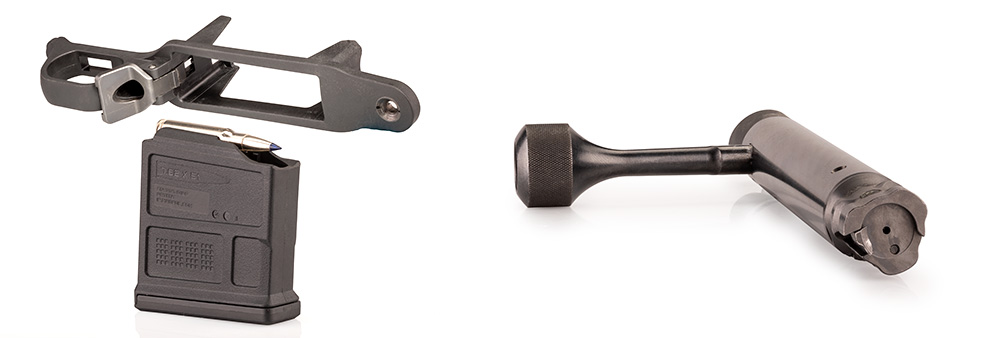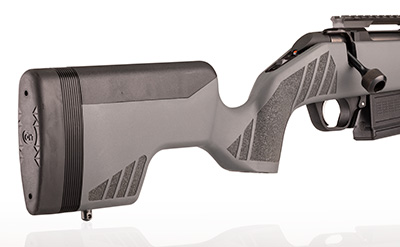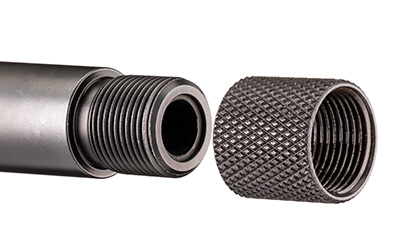
If you ask me (no one did, but this assignment gives me license to spout off), the big eye-opener in Colt’s curious re-entry into the bolt-action-rifle business is how it’s taking matters into its own hands this time. Apart from one recent military contract at Colt Canada, outside partners actually manufactured all of the eclectic succession of Colt-branded bolt guns dating back to the 1950s. Not so with Colt’s newly developed CBX line now in production at the company’s historic Hartford, Conn., factory. It seems an old dog can learn a new trick.
Accordingly, the CBX Precision Rifle created a buzz at the SHOT Show in January of this year. True to form, it is a bull-barreled sharpshooter housed in a transformable chassis, a template that’s dominating fast-growing long-range-rifle disciplines. And then nearly before that news had a chance to sink in, Colt showed up at the NRA Annual Meetings in April with the related, but markedly divergent, CBX TacHunter carbine. The CBX siblings share a mechanical blueprint that’s rather unusual in 21st-century bolt-actions but otherwise are geared for different purposes and different owners.
The CBXs also shed light on questions regarding how the company’s May 2021 acquisition by Czech-based armsmaker CZ will impact operations at Colt. The new bolt rifles’ innovative take on controlled-round feed was first seen in the CZ 600, but aside from that one feature, the CBX design, we are assured, is solely the brainchild of in-house engineers. It’s a Colt.
Two-Way Performer
For American Rifleman’s first in-depth look at the new line, I was able to get my hands on a TacHunter in .308 Win. The name says it well: Tac(tical) Hunter. Made to do both. I’m not suggesting gun names have any material effect on utility, but one that succinctly introduces itself aids prospective owners, right? A slew of well-conceived traits match up with both applications, and we’ll flesh out best-case use scenarios below.
For starters, the TacHunter is a carbine at a 39.75" overall length with a 20" barrel in my .308 Win.-chambered loaner. A 6.5 mm Creedmoor version sports a 2" longer barrel and attendant overall length. Given the current zeal for maximizing ammunition performance, it’s a little surprising that Colt would choose a short-barreled second act that optimizes mobility and handling over ballistic reach. The company could simply have swapped the Precision Rifle’s high-tech chassis stock for a more conventional one and proceeded to woo long-range hopefuls with a sufficiently different and cheaper option. Instead, it made a bold, and perhaps shrewd, decision to reach an entirely different buyer pool.
While the working parts may not include any single element that hasn’t been seen before, the combination of design features is intriguing, especially in contrast with what’s been trending in today’s vibrant bolt-action marketplace. Old-school structure mixed with premium solutions coexist alongside a few 21st-century manufacturing shortcuts. While making selective use of modern efficiencies, Colt’s blueprint doesn’t pinch pennies.

A prime example is the CBX’s flat-bottomed receiver. In full Mauser tradition, it contains more steel and requires more machining than the tubular receivers that dominate sales nowadays. Colt’s introductory notes remind us that the box-like structure possesses the superior rigidity that’s a building block for accuracy, and its track record, running through iconic Rigbys, FNs, Winchester Model 70s, Ruger Model 77s and many more, speaks for itself. That’s not to say the round-bodied breed can’t shoot straight—we all know otherwise—which is why it’s a two-horse race. Regardless, the classic stiff-sided receiver is a great foundational step.
Conversely, the bolt and lockup are evolutionary. Sans hefty dual locking lugs, the CBX co-opts the inventive bolt created for a family member, the CZ 600. In an increasingly common arrangement, the lugs are spaced 120 degrees apart on center. Typically that means three lugs, whereas the CBX bolt head has a total of six grouped in pairs. Whether it’s three or six, so-called “tri-bolt” actions have become popular in part because they unlock with a quick 60-degree lift, which can potentially boost rate of fire and facilitates large-belled scopes. More importantly, the inherent balance in three anchor points ups the odds that the bolt head will remain square with the bore under torsional forces.
The bolt body, at 0.781", is actually bigger in diameter than the lugs at 0.752". Snugged within opposing arcs formed by the receiver’s inner wall, the so-called “full-diameter” bolt’s travel is therefore smooth and easy, and the design eliminates the need for machining raceways or rails.
While the bolt face is mostly recessed, its bottom third remains open, and since ejection is handled by an inset plunger, cartridges sliding up the feed ramp freely rise into flush contact with the face. Meanwhile, a pivoting extractor hooks over the case rim and, voila! Controlled-round feed, of a sort. Rather than connecting in full-length-claw fashion as the cartridge separates from the magazine and the bolt is about halfway home, the CBX’s extractor latches on after the bolt head enters the receiver ring. At that point, the cartridge is all but chambered, but thereafter control is fixed until the case is ejected. So long as I cycled the action smartly, it was flawless, but a few hang-ups occurred when trying to feed a new round gingerly, as might happen in a close-range hunting encounter.
My sample TacHunter’s 20" barrel tapers from 1.039" at the shoulder to 0.636" at the root of the muzzle threading, for a contour falling between medium and heavy sporter. While the barrel appears to screw directly into the receiver, also present is a two-step barrel collar or nut that locks the two components together.
Especially noteworthy is that the bore is button-rifled, distinguishing it from the hammer-forged barrels so prevalent today. Button rifling is reputed to lend superior accuracy and has long been a force in benchrest and other match disciplines; however, the same is true of cut rifling, and results from current hammer-forged tubes are impressive, too. So, let’s not declare a consensus best in this area. What is undeniable is that, because button rifling can’t rival hammer-forging’s mass-production output, it is a costlier process. And so again, Colt has chosen to deliver premium value even if it’s not a priority in purchase decisions.

The stock brings utilitarian value, and though its gray molded polymer shell is rather ordinary in itself, practical design and adjustability improve it. A near-vertical pistol grip, a broad, flat fore-end and a bottom-of-the-buttstock cutout are design tweaks meant to optimize deliberate shooting from sandbags. Though it clearly leans tactical, the TacHunter profile shouldn’t turn off Boomer hunters who want their next deer rifle to resemble their previous ones. Generous stippling across the grip and fore-end should prove handy for all shooters, and sling users will find a pair of fore-end swivel studs plus one at the rear. Interestingly, those forward studs screw into a polished aluminum bar that internally spans the length of the fore-end. It’s actually an extension of a 2.4" x 0.9" mini bedding block cleverly embedded within the stock inletting at the front of the magazine well. The block’s exposed top surface mates with a flat on the underside of the receiver and features a perpendicular slot into which fits an integral recoil lug. The front action screw passes through the machined block to secure the barreled action to the stock, and the extension correspondingly stiffens the rifle’s entire front end.
Colt says TacHunter owners will be able to swap out their stock’s cheek risers and length-of-pull spacers. Although our test rifle didn’t arrive with alternates, word has it that high and low cheek inserts are forthcoming, as well as three butt spacers that provide length-of-pull options of 12.75", 13.50" or 14.25". It is my understanding they will be supplied at purchase and, though I haven’t used them, my guess is that installing replacements will involve removing the soft rubber buttpad.
Enclosed with the test rifle was a Magpul AICS five-shot detachable box magazine, a polymer construct that is head-and-shoulders better than sheet-metal magazines. They don’t corrode, the feed lips don’t bend and the material has a tiny bit of give (ductility) that promotes smooth feeding. If you happen to drop one on rocks, it’s relatively quiet. The CBX’s integrated trigger guard/magazine-well liner is also molded of polymer, which, for those with an affinity to actual “bottom metal’’ is a bit of a letdown.

Testing Highlights
Positive reports from colleagues who had previously test-fired the CBX Precision Rifle set the bar high for our range sessions with the TacHunter. While it would have been a stretch to expect the carbine to equal results from a specialized long-range platform, I hoped for group averages hovering around minute of angle. I enlisted the aid of American Rifleman Managing Editor Christopher Olsen in testing the TacHunter, as he is an excellent shot with years of experience in tramping the hunting fields with rifles.
My first indication was good. With a Leupold VX-6 3-18X 50 mm scope providing the sighting, there were six rounds remaining from a vintage box of Norma 150-grain semi-spitzers after fine-tuning the zero. Firing them into a common point of aim produced a group measuring 0.975", a very satisfying result on a blisteringly hot July afternoon.
On accuracy-testing day, temperatures were blessedly mild, and though the groups (see the nearby table) came in a few tenths bigger than our ambitions, repeated shot clustering convinced us the TacHunter is plenty accurate for the actual work it will be put to. Though American Rifleman’s test protocol of five, five-shot groups is rather stringent, it’s a small sample size, nonetheless. Owners who make an effort stand to find ammunition that aces their rifle’s accuracy potential, and with the .308 Win., scores of factory loadings are available.
As expected, the handling was slick. The rifle shouldered in a simple reflex, whereupon my cheek weld routinely landed on proper eye relief. As can occur with palm-swelled, vertical-grip stocks, I sometimes was prompted to fidget my strong hand a bit upon settling in. I think that’s the residue of “excessive” shotgun shooting, and folks accustomed to new-age grip styles won’t feel compelled to do so. For a short-barreled model, the TacHunter steadied quickly during repeat-fire drills. In fact, the lack of muzzle weight had minimal, if any, effect on our ability to steady the gun in field positions. Overall, I think the TacHunter will hold its own on long targets and really shine in close-quarters stalking encounters that culminate in immediate snap-shooting. Its short stature will certainly ease brush-busting.
The TacHunter’s single-stage trigger required compression but was smooth, consistent and free of overtravel. Mostly impressed at the first go, I was surprised to discover the factory setting was a bit more than 5 lbs. After adjusting as far as I could, to 2 lbs., 10 ozs., according to my gauge, I liked it even more. User adjustment is an easy, one-screw operation, although access to it means the barreled action must come out of the stock. The remaining controls—a sliding tang safety, a bolt release just in front of the bolt handle and a centrally mounted magazine release at the rear of the magazine well—did their jobs without fail. I especially appreciated being able to retract the bolt and unload a chambered round without deactivating the safety.

Real-World Fits For The TacHunter
No single rifle can do it all in categories as broad as hunting and tactical use. (So, no worries about American Rifleman ever running short of material!) Even so, I think the new Colt’s size, handling dynamics and shooting capability sync well with mainstream hunting, and at the same time, groom it toward a particular, well-defined role in the defense of life and property.
If your first impression regarding the TacHunter as a game-getter was “deer rifle,” join the club. Though current cartridge options are limited and somewhat redundant, the 6.5 mm Creedmoor and .308 Win. are superbly accurate, moderate on recoil and, to a point, hard-hitting. Those chamberings are as good as it gets for deer and other medium-size game and all the better fired from a well-balanced rifle in a shooter-friendly stock. The downsized package can also aid maneuverability in blinds and tree stands, and it makes it easier to get in and out of vehicles, ATVs, boats and bush planes.
Questions here relate to bigger game such as elk, moose and bears. The 6.5 mm Creedmoor probably has more naysayers than supporters in this area, because seasoned hunters are wary of the terminal performance of its lightweight 130- and 140-grain bullets. With a greater likelihood that less-than-perfect shot placement may not quickly and humanely incapacitate such large beasts, the Creedmoor requires hunters to be highly disciplined in terms of shot angle, range and the animal’s anatomy and disposition—as well as their own skill. If used, it is a tool best wielded by respectful, accomplished hunters. There are many better options, among them the .308 Win. with appropriate 165- and 180-grain loads. That notwithstanding, bears that weigh more than an NFL tackle merit even greater respect.
At 6 lbs., 15 ozs., the TacHunter is no textbook mountain rifle, but it is light and stout enough, in my opinion, for practical pursuit of high-country sheep and goats. Add in pronghorns, caribou, feral hogs and other introduced animals, and the can-do list far exceeds its big-game shortcomings. As should be evident, I think Colt’s utility turnbolt will match many hunters’ needs.

In its other vocation, the TacHunter evokes the scout rifle conceptualized some decades back by gun guru Col. Jeff Cooper. His assessment of firearms for survival in times and places where civil order and economic systems have crashed prioritized a compact, foolproof, mild-shooting rifle chambered for a widely available cartridge. The scout rifle had to be potent enough (cartridge-wise) to kill large animals for food and, at the same time, capable of returning hostile fire at ranges near and far. It had to be stalwart in home security, yet portable enough to accompany owners traveling on foot. Cooper felt that a scoped bolt-action carbine best met this criteria. A similar profile was also widely employed by law enforcement personnel to serve as a ride-along patrol rifle.
Today, AR-type/modern sporting rifles fill these jobs. The widespread familiarity and trust that made this class America’s most popular rifle, including relevant attributes like ammo capacity and rate of fire, have reset the defensive-rifle mindset. In fairness, medium-bore black rifles were rare in Cooper’s day, and constant development since has made their operating systems far more reliable.
In no way am I suggesting that defense-minded AR owners should switch to a bolt-action scout rifle; however, I will venture that an MSR paired with a scout rifle in the same cartridge would make for a super bug-out battery. For sure, a bolt gun like the TacHunter will be ready when needed, and its five-round magazine can easily be replaced with a 10-rounder.
Final Shot
On 2023’s bolt-action pricing spectrum, the CBX TacHunter’s $999 MSRP falls somewhere in the lower middle. It sure appears to succeed as a multitasker in a limited tactical role on top of a broad hunting application, and added chamberings could extend its toolbox. The engineering of the controlled-round feed bolt, along with premium touches like the flat-bottom receiver and button rifling, stack up value, and I think it’s commendable that Colt chose to mostly forgo the max-efficiency template pervasive on the contemporary bolt-action scene. Though I’m not so sure features that formerly signified better or best performance are as advantageous or in demand as much as they once were, the moderately priced end result is a gutsy move by a 187-year-old company seeking to reshape its identity.






































